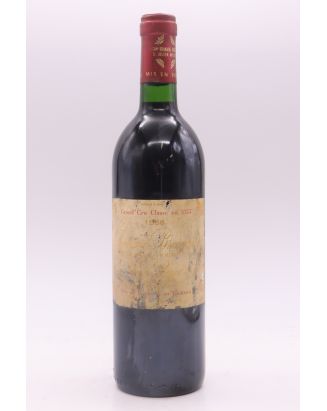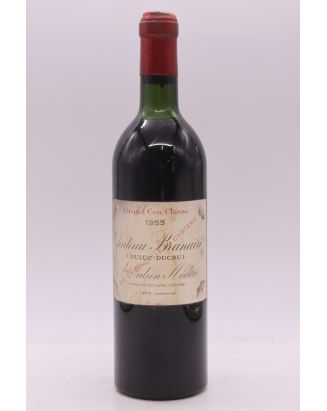














The history of Château Branaire-Ducru dates back to 1680, when a visionary Bordeaux notary, Jean-Baptiste Braneyre, decided to acquire part of the vast Beychevelle estate. He quickly perceived the potential of these gravelly lands, ideal for vine cultivation and particularly for Cabernet Sauvignon. This marked the beginning of a history that intertwines with the evolution of the classified growths of the Médoc.
The property passed through several generations of the Braneyre family, then to the descendants of Du Luc, who built the château in 1824, an elegant neoclassical residence. This château, a testament to the rich family heritage, is the setting for the production of wines that would mark their era. In 1855, on the occasion of the famous Paris Universal Exhibition, Château Branaire-Ducru was consecrated as a Fourth Classified Growth in the official classification of Médoc wines, thus confirming the exceptional quality of its terroir and wines.
The estate continued its journey under the management of various families until 1988, when Patrick Maroteaux, former president of a large agri-food company, decided to acquire it. Visionary and passionate, he undertook numerous works to modernise the property and optimise the quality of the wines. After his death in 2017, his son, François-Xavier Maroteaux, took the reins of the estate, continuing to evolve the château towards new heights of quality and innovation. Under his direction, the estate inaugurated a revolutionary 100% gravity-fed vat room in 2024, unprecedented equipment in the Médoc.
Located in the heart of the Saint-Julien appellation, Château Branaire-Ducru benefits from a unique terroir on the left bank. The quaternary gravel soils, composed of gravel and pebbles brought by the Garonne, offer optimal natural drainage, essential for the production of great red wines. This soil, rich in minerals, allows noble grape varieties such as Cabernet Sauvignon, Merlot, Petit Verdot and Cabernet Franc to flourish fully.
The Château's vineyard extends over 60 hectares, divided into about fifteen distinct micro-terroirs, each bringing a different nuance to the grapes. With a modest altitude but rounded crests overlooking the Gironde estuary, the vines benefit from a favourable microclimate, allowing perfect phenolic maturation. The average age of the vines is 35 years, but some plots have century-old vines, witnesses to a long tradition of viticulture with respect for the land.
The Château has also been committed for many years to a responsible environmental approach. Certified High Environmental Value (HVE) level 3 and ISO 14001 for its environmental management, Branaire-Ducru is also BeeFriendly labelled, guaranteeing the protection of bees and pollinators.
The vinification process at Château Branaire-Ducru is a subtle marriage between tradition and innovation. As early as 1991, the estate distinguished itself by becoming one of the first to adopt a gravity-fed vat room, an innovation that allows grapes to be treated with extreme delicacy. The principle is simple: pumping is eliminated, and the grapes are conveyed into the vats by gravity, thus preserving the integrity of the fruit.
With the inauguration of the new 100% gravity-fed vat room in 2024, equipped with 65 suspended vats, Branaire-Ducru has further improved its plot-by-plot approach, with each vineyard plot now being vinified separately, ensuring optimal expression of the terroir. This meticulous attention to each grape variety and each plot continues during fermentation, where controls are rigorous and maceration times can vary up to three weeks, depending on the potential of each vintage.
The blending, a true art at Château Branaire-Ducru, has been directed since 2002 by Jean-Dominique Videau, a talented technical director. He carefully composes the wines from the different grape varieties to create a perfect harmony between aromatic complexity, freshness and finesse. Finally, the wine is aged for 16 to 20 months in French oak barrels, of which 60 to 65% are new each year, allowing the wine to improve slowly while developing subtle aromas of wood and spices.
Château Branaire-Ducru produces two main cuvées:
Château Branaire-Ducru
This grand vin, produced from the best plots of the estate, embodies the elegance and complexity of Saint-Julien wines. Predominantly composed of Cabernet Sauvignon (65%), it develops aromas of black fruits, blackcurrant, cedar and spices, with a refined tannic structure that ensures excellent ageing potential. Merlot (28%) brings roundness and suppleness, while Petit Verdot (4%) and Cabernet Franc (3%) add a floral and spicy touch. This wine is distinguished by its finesse, vibrant fruit and freshness.
Duluc de Branaire-Ducru
The estate's second wine, Duluc is produced from the young vines of the Château and offers a more accessible approach to the Branaire-Ducru terroir. With gourmet aromas of red fruits, a supple texture and a tangy finish, this wine will seduce amateurs in search of an elegant Saint-Julien at a more affordable price. It is also an excellent choice for discovering the estate's imprint before turning to the grand vin.
Saint-Julien, a flagship appellation of the Médoc in Bordeaux, is renowned for its red wines of great finesse and longevity. Certain vintages particularly stand out for their exceptional quality, offering powerful, elegant and complex wines. Among the finest vintages, one finds years such as 1975, 1982, 1985, 1986, 1989 and 1990, which are true benchmarks for connoisseurs of age-worthy wines. More recent years have not been left behind, with notable vintages such as 1995, 1996, 2000, 2003, 2005, 2008, 2009, 2010, and 2012, all praised for their balance and ageing potential. The years 2014, 2015, 2016, 2017, 2018, 2019 and 2020 also distinguish themselves through their richness and complexity, continuing to make Saint-Julien an essential reference in the world of wine.
Discover the full range of Fourth Classified Growths from Bordeaux, each one representing the richness of the Médoc's prestigious terroirs. In Saint-Julien, explore the wines of Château Beychevelle, Château Branaire-Ducru, and Château Talbot. In Pauillac, Château Duhart-Milon offers wines with the typical character of the appellation, while Château Lafon-Rochet in Saint-Estèphe provides robust vintages. In the Haut-Médoc, Château La Tour Carnet stands out, while Margaux's reputation is upheld by estates such as Château Marquis de Terme, Château Pouget, Château Prieuré-Lichine, and Château Saint-Pierre. Each of these estates reflects, in its own way, the unique identity of the Fourth Growths.
Château Branaire-Ducru is undoubtedly one of the most prestigious properties in the Médoc, combining exceptional terroir, precise vinification and a strong commitment to the environment. Thanks to the constant efforts of the Maroteaux family, this estate continues to produce wines of rare elegance, distinguished by their finesse, complexity and ability to age harmoniously. Whether you opt for the grand vin or for Duluc de Branaire-Ducru, you are assured of tasting an exceptional wine, reflecting the excellence of Saint-Julien.